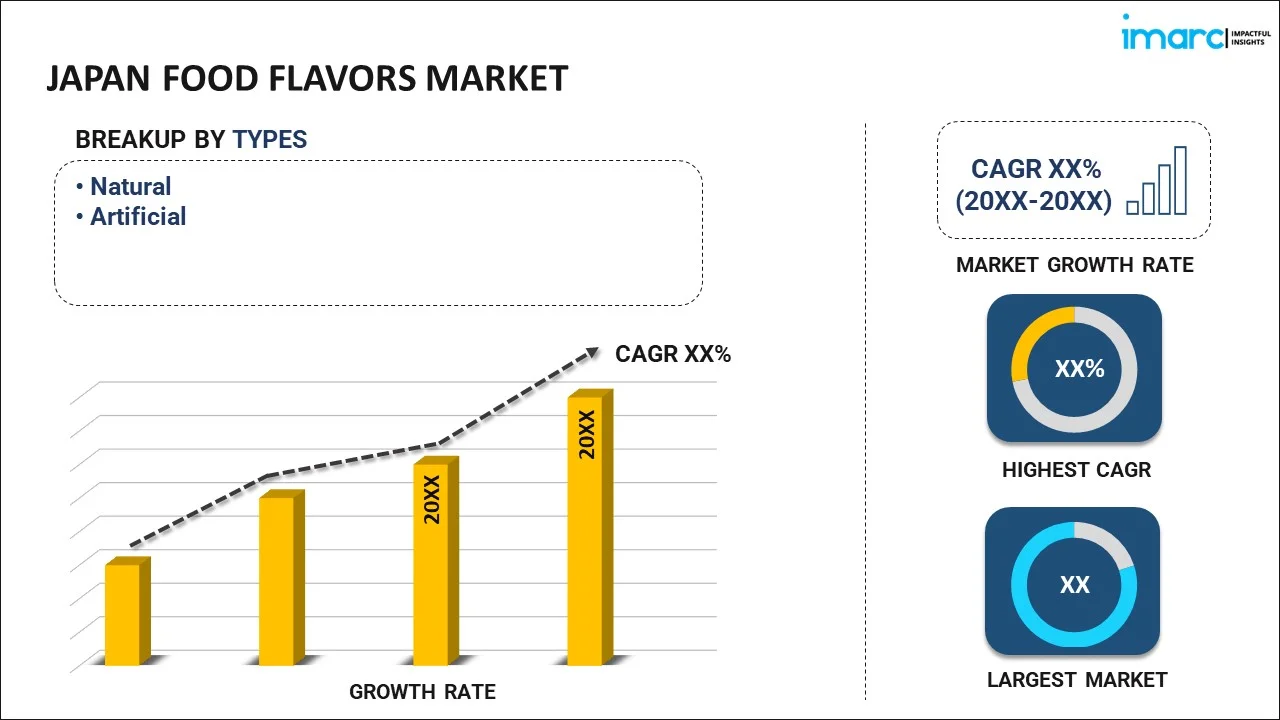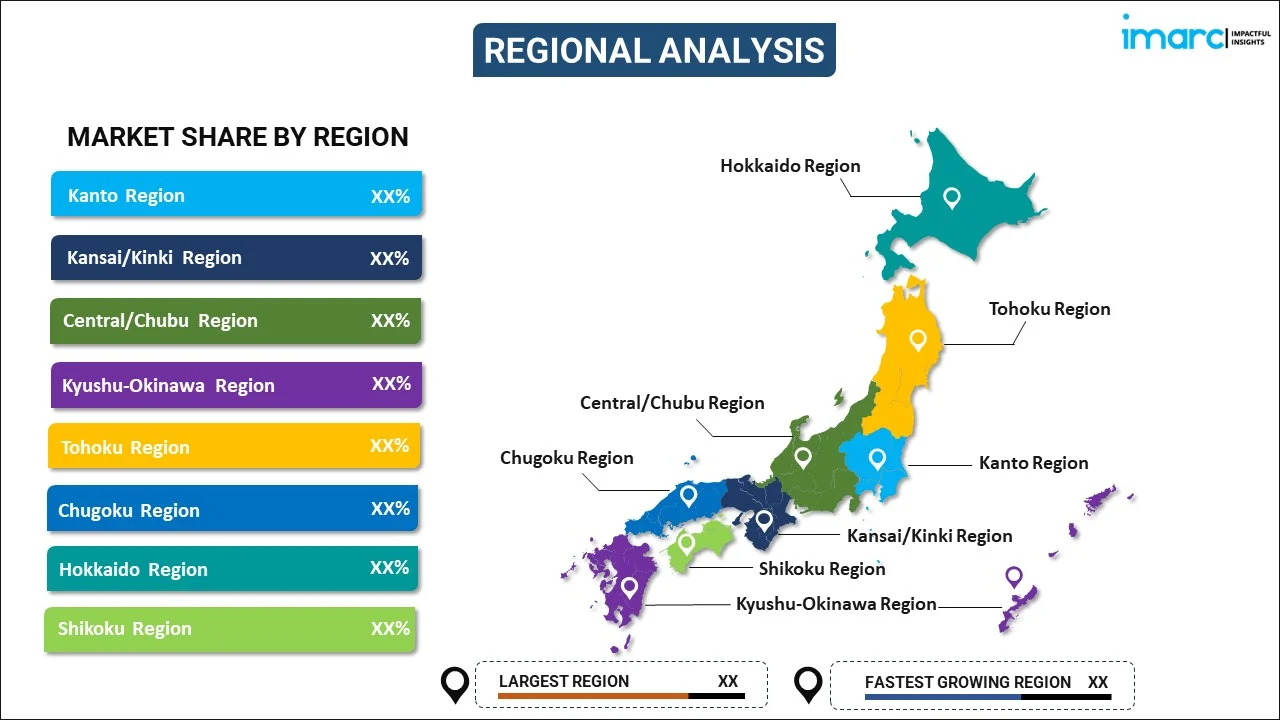
Japan Food Flavors Market Report by Type (Natural, Artificial), Form (Dry, Liquid), End User (Beverages, Dairy and Frozen Products, Bakery and Confectionery, Savory and Snacks, Animal and Pet Food), and Region 2025-2033
Market Overview:
Japan food flavors market size reached USD 752.5 Million in 2024. Looking forward, IMARC Group expects the market to reach USD 1,181.0 Million by 2033, exhibiting a growth rate (CAGR) of 4.75% during 2025-2033. The rising advancements in flavor extraction, encapsulation, and delivery technologies, which enable the creation of more potent and stable flavors, are driving the market.
|
Report Attribute
|
Key Statistics
|
|---|---|
|
Base Year
|
2024 |
|
Forecast Years
|
2025-2033
|
|
Historical Years
|
2019-2024
|
| Market Size in 2024 | USD 752.5 Million |
| Market Forecast in 2033 | USD 1,181.0 Million |
| Market Growth Rate (2025-2033) | 4.75% |
Food flavors refer to the sensory attributes that enhance the taste and aroma of various food products. Food flavors are a complex combination of taste, smell, and mouthfeel, which together create a unique and pleasurable eating experience. Taste, one of the primary components of food flavor, includes basic sensations like sweet, salty, sour, bitter, and umami. These tastes are detected by the taste buds and provide the foundation for the perception of flavor. However, the full experience of flavor also involves a sense of smell, as volatile compounds released from the food interact with receptors in the nose. Mouthfeel, another critical element, refers to the texture and physical sensations experienced while eating. This can include qualities like creaminess, crunchiness, or smoothness, and it greatly influences the perception of a food's overall flavor. In summary, food flavors encompass a multi-dimensional experience that combines taste, smell, and mouthfeel to create the delightful and diverse sensations with different foods.
Japan Food Flavors Market Trends:
The food flavors market in Japan is experiencing robust growth due to several key drivers that are shaping the industry landscape. Firstly, consumers' growing demand for unique and exciting culinary experiences has been a significant catalyst. Furthermore, the health-conscious consumer base is steering the market towards natural and clean-label flavors as they seek healthier alternatives without compromising on taste. Moreover, advancements in food technology have enabled flavor manufacturers to create innovative and sophisticated flavor solutions, enhancing the overall sensory appeal of food products. Furthermore, the expanding middle-class population and urbanization in Japan are driving the demand for convenience foods and packaged goods, which rely heavily on food flavors to enhance taste and appeal. Lastly, regulatory support for sustainable and environmentally friendly flavor production methods is further propelling market growth as sustainability becomes a focal point for consumers and businesses alike. Additionally, the rise of e-commerce and digital marketing, which has expanded the reach of food products, making it easier for consumers to discover and purchase new flavors online, is expected to drive the food flavors market in Japan during the forecast period.
Japan Food Flavors Market Segmentation:
IMARC Group provides an analysis of the key trends in each segment of the market, along with forecasts at the country level for 2025-2033. Our report has categorized the market based on type, form, and end user.
Type Insights:

- Natural
- Artificial
The report has provided a detailed breakup and analysis of the market based on the type. This includes natural and artificial.
Form Insights:
- Dry
- Liquid
A detailed breakup and analysis of the market based on the form have also been provided in the report. This includes dry and liquid.
End User Insights:
- Beverages
- Dairy and Frozen Products
- Bakery and Confectionery
- Savory and Snacks
- Animal and Pet Food
The report has provided a detailed breakup and analysis of the market based on the end user. This includes beverages, dairy and frozen products, bakery and confectionery, savory and snacks, and animal and pet food.
Regional Insights:

- Kanto Region
- Kansai/Kinki Region
- Central/ Chubu Region
- Kyushu-Okinawa Region
- Tohoku Region
- Chugoku Region
- Hokkaido Region
- Shikoku Region
The report has also provided a comprehensive analysis of all the major regional markets, which include Kanto Region, Kansai/Kinki Region, Central/ Chubu Region, Kyushu-Okinawa Region, Tohoku Region, Chugoku Region, Hokkaido Region, and Shikoku Region.
Competitive Landscape:
The market research report has also provided a comprehensive analysis of the competitive landscape. Competitive analysis such as market structure, key player positioning, top winning strategies, competitive dashboard, and company evaluation quadrant has been covered in the report. Also, detailed profiles of all major companies have been provided.
Japan Food Flavors Market Report Coverage:
| Report Features | Details |
|---|---|
| Base Year of the Analysis | 2024 |
| Historical Period | 2019-2024 |
| Forecast Period | 2025-2033 |
| Units | Million USD |
| Scope of the Report | Exploration of Historical Trends and Market Outlook, Industry Catalysts and Challenges, Segment-Wise Historical and Future Market Assessment:
|
| Types Covered | Natural, Artificial |
| Forms Covered | Dry, Liquid |
| End Users Covered | Beverages, Dairy and Frozen Products, Bakery and Confectionery, Savory and Snacks, Animal and Pet Food |
| Regions Covered | Kanto Region, Kansai/Kinki Region, Central/ Chubu Region, Kyushu-Okinawa Region, Tohoku Region, Chugoku Region, Hokkaido Region, Shikoku Region |
| Customization Scope | 10% Free Customization |
| Post-Sale Analyst Support | 10-12 Weeks |
| Delivery Format | PDF and Excel through Email (We can also provide the editable version of the report in PPT/Word format on special request) |
Key Questions Answered in This Report:
- How has the Japan food flavors market performed so far and how will it perform in the coming years?
- What has been the impact of COVID-19 on the Japan food flavors market?
- What is the breakup of the Japan food flavors market on the basis of type?
- What is the breakup of the Japan food flavors market on the basis of form?
- What is the breakup of the Japan food flavors market on the basis of end user?
- What are the various stages in the value chain of the Japan food flavors market?
- What are the key driving factors and challenges in the Japan food flavors?
- What is the structure of the Japan food flavors market and who are the key players?
- What is the degree of competition in the Japan food flavors market?
Key Benefits for Stakeholders:
- IMARC’s industry report offers a comprehensive quantitative analysis of various market segments, historical and current market trends, market forecasts, and dynamics of the Japan food flavors market from 2019-2033.
- The research report provides the latest information on the market drivers, challenges, and opportunities in the Japan food flavors market.
- Porter's five forces analysis assist stakeholders in assessing the impact of new entrants, competitive rivalry, supplier power, buyer power, and the threat of substitution. It helps stakeholders to analyze the level of competition within the Japan food flavors industry and its attractiveness.
- Competitive landscape allows stakeholders to understand their competitive environment and provides an insight into the current positions of key players in the market.
Need more help?
- Speak to our experienced analysts for insights on the current market scenarios.
- Include additional segments and countries to customize the report as per your requirement.
- Gain an unparalleled competitive advantage in your domain by understanding how to utilize the report and positively impacting your operations and revenue.
- For further assistance, please connect with our analysts.
 Inquire Before Buying
Inquire Before Buying
 Speak to an Analyst
Speak to an Analyst
 Request Brochure
Request Brochure
 Request Customization
Request Customization




.webp)




.webp)












